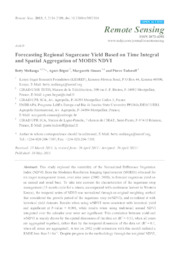Forecasting regional sugarcane yield based on time integral and spatial aggregation of MODIS NDVI.
Forecasting regional sugarcane yield based on time integral and spatial aggregation of MODIS NDVI.
Author(s): MULIANGA, B.; BÉGUÈ, A.; MEIRELLES, M. S. P.; TODOROFF, P.
Summary: This study explored the suitability of the Normalized Difference Vegetation Index (NDVI) from the Moderate Resolution Imaging Spectrometer (MODIS) obtained for six sugar management zones, over nine years (2002?2010), to forecast sugarcane yield on an annual and zonal base. To take into account the characteristics of the sugarcane crop management (15-month cycle for a ratoon, accompanied with continuous harvest in Western Kenya), the temporal series of NDVI was normalized through an original weighting method that considered the growth period of the sugarcane crop (wNDVI), and correlated it with historical yield datasets. Results when using wNDVI were consistent with historical yield and significant at P-value = 0.001, while results when using traditional annual NDVI integrated over the calendar year were not significant. This correlation between yield and wNDVI is mainly drawn by the spatial dimension of the data set (R2 = 0.53, when all years are aggregated together), rather than by the temporal dimension of the data set (R2 = 0.1, when all zones are aggregated). A test on 2012 yield estimation with this model realized a RMSE less than 5 t·ha?1. Despite progress in the methodology through the weighted NDVI, and an extensive spatio-temporal analysis, this paper shows the difficulty in forecasting sugarcane yield on an annual base using current satellite low-resolution data. This is particularly true in the context of small scale farmers with fields measuring less than the size of MODIS 250 m pixel, and in the context of a 15-month crop cycle with no seasonal cropping calendar. Future satellite missions should permit monitoring of sugarcane yields using image resolutions that facilitate extraction of crop phenology from a group of individual plots.
Publication year: 2013
Types of publication: Journal article
Unit: Embrapa Soils
Keywords: MODIS, NDVI, Yield forecasting, environment, sugarcane
Observation
Some of Embrapa's publications are published as ePub files. To read them, use or download one of the following free software options to your computer or mobile device. Android: Google Play Books; IOS: iBooks; Windows and Linux: Calibre.
Access other publications
Access the Agricultural Research Database (BDPA) to consult Embrapa's full library collection and records.
Visit Embrapa Bookstore to purchase books and other publications sold by Embrapa.

